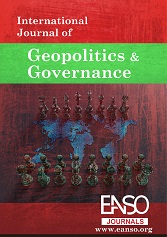Context Informing the Adoption of Regional Security Initiatives for the Control of Small Arms and Light Weapons in East Africa
Abstract
The proliferation of SALWs in the East African region has negatively impacted both national and regional security. Porous and expansive borders, corruption, and instability in the region, commercialization of cattle rustling, weak governments and the presence of ungoverned spaces in the region, have facilitated the proliferation of SALWs in the region. This article presents the findings on the initiatives adopted by Kenya and Uganda, both individually and collaboratively for the control of the proliferation of SALWs in East Africa. The study was guided by the regionalism theory of inter-state cooperation and a descriptive survey design. The sampled respondents totalling 55 were drawn from the security agencies, members of civil societies, foreign relation offices, non-state actors and religious leaders. Instrumentation encompassed questionnaires, focus group discussions and interviews. The findings indicate the context that entails armed robberies, cattle rustling, and conflicts between communities and in urban areas like Nairobi, illegal firearms can be purchased relatively cheaply. Similarly, SALWs are used by various non-state actors, including rebel groups and criminal gangs, which exacerbates instability and hampers peace efforts. This context forms a critical need for comprehensive strategies that address the SALW proliferation, enhance regional collaboration, and improve public awareness to effectively mitigate the associated security threats. The study recommends that the governments of Kenya and Uganda should enhance the recruitment, training, and deployment of sufficient security troops to the Northeast of Uganda and the Northwestern region of Kenya
Downloads
References
Amasava, C. (2023). Government Peace Building Strategies in Mitigation of Natural Resource Induced Conflicts Between Communities of West Pokot and Turkana Counties, Kenya. 10.29322/IJSRP.13.05.2023.p13729.
Falk, R. A., & Barnet, R. J. (2015). Security in Disarmament.
Human Rights Watch. (2020). New Weapons, Proven Precedent: Elements of and Models for a Treaty on Killer Robots.
IANSA and International Peace Information Service (IPIS). (June 2022). Small Arms and Light Weapons Proliferation and Violence: Estimating its Scale and Forms.
Katsina, A.M., Mashi, M.A. & Abdullahi, M. (2021). Armed Conflicts, SALWs Proliferation, and Underdevelopment in Africa. In: Tar, U.A., Onwurah, C.P. (eds) The Palgrave Handbook of Small Arms and Conflicts in Africa. Palgrave Macmillan, Cham. https://doi.org/10.1007/978-3-030-62183-4_13
Mkutu, Kennedy. 2003. Pastoral Conflict and Small Arms: The Kenya- Uganda Border Region. Safer world.
Mugo, A. K. (2023). The Influence of the Porous Kenya-Uganda Boarder on the Proliferation of Small Arms and Light Weapons in East African Region (Doctoral dissertation, University of Nairobi).
Ndawana, E., Hove, M., & Ghuliku, S. D. (2018). Tanzania: Small Arms Proliferation in East Africa and National Security. Conflict Studies Quarterly, (23).
Powell, J. (2010). Karamoja: A literature review. Saferworld.
Shalom Center. (April 16, 2021). Building Peace Across Eastern Africa: Chairman’s Report on Progress in 2020).
Schilling, J., Opiyo, F.E. & Scheffran, J. Raiding pastoral livelihoods: motives and effects of violent conflict in north-western Kenya. Pastoralism 2, 25 (2012). https://doi.org/10.1186/2041-7136-2-25.
Copyright (c) 2025 Isaac Mwenda Meme, Boniface Muoka, PhD, Peter Wekesa, PhD

This work is licensed under a Creative Commons Attribution 4.0 International License.




























